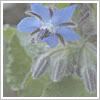 | BORAGEThis plant is particular, with bright blue, star-shaped petals, hairy stems and black, needle-like inner petals surrounding the centre. They have hairy leaves and stems and long broad laves with deep grooves. It has a sweet, honey-like taste.GROWTH SEASON: They flower early and mid greenleaf. GROWTH AREA: It grows wild everywhere, but can be found alongside ditches especially. CANON USE(S): Brings down fever and helps nursing queens supply milk for kits. EXTENDED USE(S): Effective to bring down fevers and also anti-poison for beestings, and snakebites. They can also dispel phlegm. |
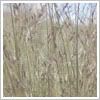 | BROOMThe common broom of England that is likely seen in the books is a deciduous shrub with dense, slender green stems, very small leaves and big, bright yellow flowers that have a round bulb at the bottom. Unlike a lot of flowers and herbs medicine cats use, it can thrive in very hot drought weather.GROWTH SEASON: flower in greenleaf and seed before leafbare. GROWTH AREA: common countryside herb. CANON USE(S): poultice for broken limbs. EXTENDED USE(S): chewing on the stalks may prove useful for treating toothaches. |
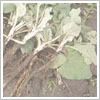 | BURDOCKGROWTH SEASON: Flower from mid-greenleaf to mid-leaf-fall.GROWTH AREA: Burdock is a common plant, but is most likely found alongside thunderpaths, and by ditches and water. CANON USE(S): the roots chewed make an effective counter-poision that is used to prevent infections in rat bites. EXTENDED USE(S): can be used to treat aching joints/bones by wetting the leaves in water and placing them on the afflicted area. |
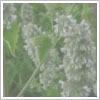 | CATMINT/CATNIP/NEPSupported with sturdy stems and heart shaped gray-green leaves, the flower of the catmint herb cluster at the end of the stems and are coloured in white, blue, pink and most commonly lilac. They have a sharp, biting taste and a delicious smell.GROWTH SEASON: flower mid-greenleaf and begin to die the first early frosts. GROWTH AREA: catmint is rare in the wild and can often be found near twoleg nests. CANON USE(S): catmint is a very important herb for the treatment of greencough. EXTENDED USE(S): effective for relieving coughs, aches, shortness of breath and other symptoms of colds (including whitecough and greencough). |
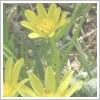 | CELANDINECeladine has a bright yellow flower split into four distinctive petals, and the stalks are hairy, green and brittle. The leaves are large and serrated, though the edges are rounded.GROWTH SEASON: they flower all greenleaf. GROWTH AREA: old walls and twoleg gardens. CANON USE(S): treats sore eyes. (no treatment application available) EXTENDED USE(S): when the eyes are sore the juices and poultice can aid the eyes, when mixed with chamomile and applied in a poultice to the stomach, it can aid in relieving bellyaches and pains of a pregnant queen. |
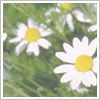 | CHAMOMILEA long-standing soothing herb which has a gentle aromatic smell and taste that is calming when digested or just scented. Chamomile it's self have thin spindley, erect stems with small white petals and yellow centres. The flowered stems have small, jagged leaves. They grow about a mousetail or two high.GROWTH SEASON: growing season is short and lasts only two greenleaf moons. GROWTH AREA: chamomile grows in full sun. CANON USE(S): soothes anxiety. (no treatment application available) EXTENDED USE(S): coming soon |
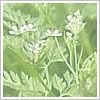 | CHERVILThis fern has large, spreading leaves with jagged edges and small white flowers. Chervil has a scent much like it's taste: sweet, warm and grassy, while younger leaves have a slighter more pungent, bitter taste.GROWTH SEASON: flower and seed in early newleaf. GROWTH AREA: common in meadows, twoleg gardens and hedge-sides. CANON USE(S): good poultice to apply to infected wounds, and roots can be chewed up for bellyache. EXTENDED USE(S): bruise, chew or soak the chervil and apply to decrease swelling and blood. |
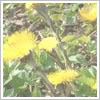 | COLTSFOOTColtsfoot has straight dark gray stalks and small yellow flowers that resemble dandelion heads. Sometimes the leaves are very small, while a fully matured plant has medium-sized green pale-veined leaves which only appear after the flowers die off. The leaves have a bitter taste.GROWTH SEASON: flowers in mid-leafbare and seeds in early newleaf. GROWTH AREA: coltsfoot is common in both wet and dry areas. CANON USE(S): aids with shortness of breath when digested. EXTENTED USE(S): a poultice made of the flowers can have a soothing effect on bites and swelling. |
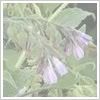 | COMFREYThis plant has large hairy green leaves attached to equally hairy tough green stalks at the end of which grow small weepy, pale violet flowers in little bundles. It is a subtle, fresh watery smell and tastes like cucumber (subtle and fresh).GROWTH SEASON: they flower early in the season and seed in late greenleaf. GROWTH AREA: found in ditches, alongside water and in moist fields. CANON USE(S): comfrey is used to heal broken bones and relieve pain from wounds, which can be done by wrapping the wound or area with the leaves. EXTENTED USE(S): nearly all parts, especially the roots and leaves are useful for healing bruises and wounds. |
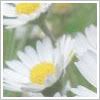 | DAISYThis wild flower has narrow white petals and a bulging yellow centre. It has small creeping roots and green leaves. Leading up to the flower is a leafless stem that stands about two mousetails high (6 inches). They close during the night.GROWTH SEASON: flowers early newleaf. GROWTH AREA: very common. CANON USE(S): treats aching joints. (no treatment application available) EXTENTED USE(S): Speeds the healing of wounds when applied as a poultice to area, as well as soar muscles and joints. Juice can be squeezed into streaming eyes to aid them. |
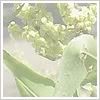 | DOCKThe dock plant comes in two common forms. One (British dock) has long roots and fairly skinny, fleshy leaves. It has stiff stalks covered with small, pale, yellow-green flowers, while the other (broad-leafed dock) has stuff stalks with broad veined leaves which form small patches close to the ground much like rhubarb, and tastes very similar (very tart and sour).GROWTH SEASON: flowers in early newleaf and begins to wilt late greenleaf. GROWTH AREA: they grow in moist areas that attract a lot of water. CANON USE(S): soothes scratches. (no treatment application available) EXTENTED USE(S): rashes can be treated with dock roots. |
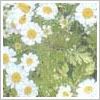 | FEVERFEW/FEATHERFEWSimilar in appearance to the daisy, the feverfew has small, rounded white petals and a yellow centre. The flower can be told apart by a small indent in the middle of the thrum, and large strong citrus-smelling leaves with serrated edges. Unkept it grows into a small bush about a tail-length and a half tall (18 inches). It has a very bitter taste.GROWTH SEASON: flowers all through early and mid greenleaf. GROWTH AREA: can be found all over growing wild, and sometimes found twoleg gardens. CANON USE(S): treats high fevers when digested (recommended with honey to disguise bitter taste). EXTENTED USE(S): good herb to give queens after kitting, and can also aid in coughs and sore thoughts when digested. A coarse poultice of the herb can be applied to the head to aid in headaches coming from colds. |
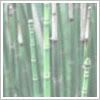 | HORSETAILHard, rough hollow stalks make the horsetail a distinctive plant, and they have small narrow leaves that spread along the ground. In dry seasons the ends can turn brown and tough, but a medicine cat will try to find the waxier, greener stalks to use. They are separated into distinctive sections as they grow taller, and come to about a tail-length long. Left to their own nature, they grow into spindly bushes. Some have fanned out needles like pine trees, while other do not. They have thin creeping roots.GROWTH SEASON: spring up in early newleaf, and seed in late greenleaf. GROWTH AREA: can be found in wet, marshy area. CANON USE(S): the leaves treats infected wounds. (no treatment application available) EXTENTED USE(S): good for stopping bleeding, application as being chewed and then licking the wound with the juices. |
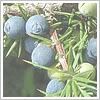 | JUNIPERThis large, tree-bush is very prickly, and caution should be taken while treading around it and when harvesting berries lest someone get a pickle stuck in their pad. The "leaves" that is, the nasty prickles, are evergreen and short with tapered edges. The berries are a smoky blue colour, with a faint almost dusty covering. The bark is rough and splintery.GROWTH SEASON: berries ripe (blue/black) in leaf-fall, and should not be harvested green. GROWTH AREA: grow in woodland areas. CANON USE(S): treats bellyaches and aids in breathing. (no treatment application available) EXTENDED USE(S): a counter-poision traditionally effective against snake bites and beestings, they are also very useful for stomach pains and cramps, and those suffering from shortness of breath. The herb can also be given to nursing queens before kitting. |
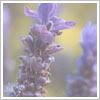 | LAVENDERThis plant is fairly tall with thin, woody stems and tall violet flowers with small orange bits. The leaves are narrow and thick with a gray-green colour, they grow beside the flowers in different stalks (the flower stalks have no leaves). It has a strong, relaxing floral scent and a sweet, floral flavor.GROWTH SEASON: flowers mid greenleaf. GROWTH AREA: can be found in wet, marshy area. CANON USE(S): treats chills and can also treat anxiety. (no treatment application available) EXTENDED USE(S): good for stopping bleeding, application as being chewed and then licking the wound with the juices. |
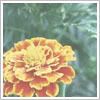 | MARIGOLDThe marigold is a distinctive bright orange flower with a darker orange centre and the petals yellowing slightly as they approach it. The leaves are long and narrow strips and are somewhat waxy in texture. Sometimes the leaves are sweet tasting, but more commonly bitter or spicy.GROWTH SEASON: flower all greenleaf, and sometimes even into leafbare. GROWTH AREA: marigolds are a common plant in the English countryside and among twoleg gardens. CANON USE(S): prevents infection. (no treatment application available) EXTENDED USE(S): the flowers eaten, both dried or fresh, are soothing for the heart and anxiety. |
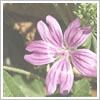 | MALLOWThis small plant has deeply veined, spiky leaves with serrated edges and a pale to darker pink flower with darker streaks of colour on the thin petals, and an even darker centre. Flowers often have five or so petals. It has a tall, strong stem which supports the plant and can grow up to nearly one and a half foxlengths tall (1 - 2 m).GROWTH SEASON: flower mid greenleaf and go down just as the leafbare kills them. GROWTH AREA: a marsh plant which grows in moist, light soil. CANON USE(S): poultice for broken limbs. (no treatment application available) EXTENDED USE(S): the leaves soaked in water and placed on the stomach can relieve bellyaches, heal ailments of the eyes as well as replenish a queen's supply of milk when applied in the same way. The leaves chewed and digested before a queen's kitting can also help it go smoothly. Digestion of the roots can expel poisons, though yarrow is more effective. Poultice of the leaves mixed with barley flower can decrease swelling and is useful for healing bruises and breaks. |
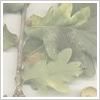 | OAKThe oak tree is generally large and round, and can grow very big (like the Sky Oak in ThunderClan territory) with a thick trunk and long stretching branches. The leaves are very distinctively shaped, almost deeply serrated with very round edges. The fruit of the tree is called acorns, and are small smooth brown pods with caps that attach them to the tree.GROWTH SEASON: deciduous tree that develops fruit and grows leaves in newleaf and greenleaf, and begins to shed them in leaf-fall. Bare by leafbare. GROWTH AREA: common tree in english countryside, particularly in woodland. The Sky Oak, the biggest oak near the lake, is within ThunderClan territory. CANON USE(S): dried oak leaves can prevent infection. (no treatment application available) |
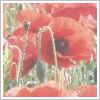 | POPPYThe corn poppy is a blood red flower with large fleshy thin petals and a dark black centre. The stalks are tall and straight, with small thin leaves clustered around the bottom halves.GROWTH SEASON: flower (seeds become ripe) mid-newleaf to greenleaf. GROWTH AREA: corn fields, ditches, hedge sides. CANON USE(S): mild sedative that can be used to calm anxiety and to dull pain when digested. It is recommended that not enough is given to dull all the pain, as pain is an indicator of healing. Poppy is the most common supply, and should be kept in large number. EXTENDED USE(S): in actual fact, poppy seeds are a deadly toxin to cats; Culpepper lists it rightly as a pain killer among other things, though it's no use to list them as they have a high likelyhood of killing cats if used. |
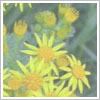 | RAGWORTThe ragwort plant has bright yellow flowers with a slightly darker yellow centre. The petals are distinctively spread out and thin. The leaves are long and serrated, they follow the stem towards and have deep veins, like those of a dandelion weed. The stems are slightly curvy and brown in colour, with heart shaped green leaves.GROWTH SEASON: flower in greenleaf and seed late in the season. GROWTH AREA: wild pastures and fields. CANON USE(S): ragwort is a travelling herb when digested. EXTENDED USE(S): good for digestion, and when digested the juice is good for healing wounds. When applied as a poultice it can also treat aching joints/bones. |
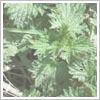 | STINGING NETTLEThis nettle has a prickly stem, the same that coat the prickly leaves. The long heart-shaped leaves are broad and deeply veined, sloping downwards. The flowers are more like small folded green buds that hang down from small stems around the leaves. Careful to avoid the stinging hairs, or you'll have quite an inch on your paws for a bit.GROWTH SEASON: springs up in newleaf and dies in leafbare. GROWTH AREA: a common countryside plant. CANON USE(S): treats swelling. (no treatment application available) EXTENDED USE(S): the roots and leaves, bruised into a poultice and mixed with honey helps to open the lungs and cure shortness of breath and sore throats when taken directly or applied to the throat. The seed eaten is a good remedy against beestings and venomous bites, and the juice of the leaves applied to wounds, bruises and scratches will take away pain. |
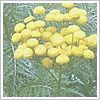 | TANSYThis flowering herb has yellow buttonlike flowers on a stout green (sometimes reddish) smooth stem which branches out to create the flat bed of clustered flowers on the top. The leaves are fernlike and spread. It smells much like an evergreen with a hint of citrus, and has a bitter taste like grass.GROWTH SEASON: flowers through greenleaf. GROWTH AREA: grows nearly everywhere. CANON USE(S): the leaves treats coughs. (no treatment application available) EXTENDED USE(S): chewed on with honey can help tooth aches. |
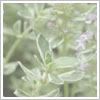 | THYMEAn aromatic herb has small, board-oval shaped leaves on a vine-like stem. It has a slightly spicy pine and lemon flavor, of which it's scent in similar.GROWTH SEASON: grows in newleaf and through greenleaf and leaf-fall. GROWTH AREA: barren areas, such as moors. CANON USE(S): calms the nerves and shock when digested. EXTENDED USE(S): thyme digested is a good remedy for shortness of breath, and is also good to give queens to ensure a quick and safe kitting. |
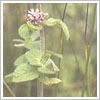 | WATER MINTThis marsh plant is a tall standing plant with a thick stem and deeply veined leaves that are an ivy-green colour which become a brown-red as they grow closer to the stem. The leaves, which hang down cover the stem which ends in a pale-pink white flower ball with darker violet-pink insides. It has a gentle, citrus smell.GROWTH AREA: Marshy, watery areas. CANON USE(S): treats bellyache. (no treatment application available) EXTENDED USE(S): none, as this type of mint is unlisted by Culpepper. |
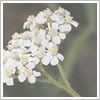 | YARROWThis common herb has finely divided, feather leaves and tiny white or yellow flowers that form a flat-topped cluster at the ends of the thin stems. It tastes and smells disgusting, much like mousebile.GROWTH SEASON: flowers late in greenleaf. GROWTH AREA: pastures. CANON USE(S): when digested it induces vomiting, which can clear poisons out of the body. EXTENDED USE(S): None. Cats vomit when they eat it! -credit to warrior's wish for list of herbs- |
Herbs
Subscribe to:
Comments (Atom)

No comments:
Post a Comment
hey there! you wanna join a clan? well here is how to join!
name:
rank:
gender:
about/history